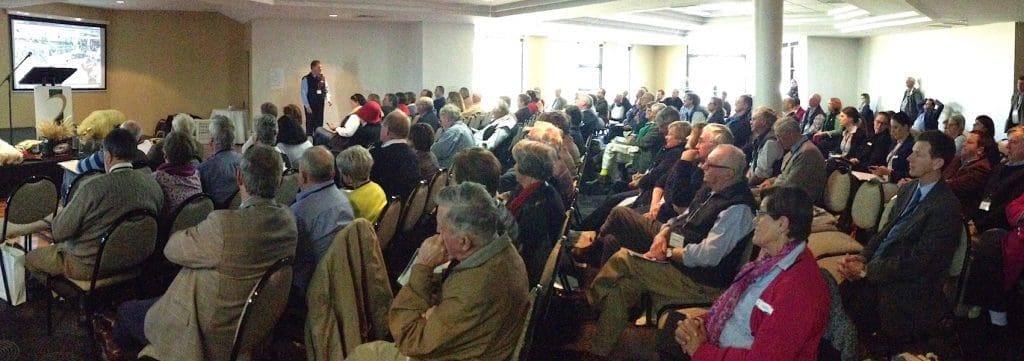
Delegates at the AgForce State Conference in Toowoomba watch a video presentation of robotic meat processing in action at JBS’ Bordertown plant.
If you are in the beef or sheepmeat industry and haven’t yet heard terms like VISNIR probes, hyperspectral imaging or SEXA and DEXA analysis, you can expect to hear a lot more about them soon.
They are among several technologies being trialled by MLA which are enabling precise, real-time and automated measurements of meat yield and eating quality traits during processing.
The same technology is also making it possible for abattoirs to process carcases using robotic automation, which is seen as one of the most achievable ways to reduce the high costs of processing in Australia.
Meat & Livestock Australia’s Dr Alex Ball updated last week’s AgForce State Conference on the progress of a range of new technologies currently being trialed, which are paving the way towards genuine value-based marketing and higher payments for higher quality meat.
The work has significant implications for measuring lean meat yield as it will potentially replace single site measurements such as p8 and rib fat in beef and GR mesasurement site in lambs with more accurate readings.
Upon hearing Dr Ball discuss these new technologies at last week’s AgForce State Conference in Toowoomba, one skeptical audience member uttered the comment that “pigs might fly first”.
But the fact is these technologies are already working and being proven in Australian processing plants, and providing a genuine example of how producer and processor levy funds can deliver important advances for the industry.
Robotic technology has been trialled at JBS’ Bordertown plant for the past two years, and is now processing up to 8,000 lamb carcases per day (see video below)
Dr Ball told the conference that the precision and efficiency gained through the automation meant the technology had effectively paid for itself within a short time period.
Five lamb plants are now trialing robotic processing, and, in another significant development, Dr Ball told the conference that two beef plants are set to trial the measurement technology on cattle carcases within 12 months.
These advances have been made possible by MLA research into whether imaging technology used for other purposes such as human medicine and video gaming can be repurposed to perform live and accurate measurements of key meat yield and eating quality parameters.
Devices trialed included VISNIR probes, CT scanning, hyperspectral imaging, Single Emission X-Ray Analysis and Dual Emission X-Ray Analysis (SEXA and DEXA) and three-dimensional RGB cameras.
These technologies mean it is now possible to obtain real-time and highly accurate objective measurement during processing of fat, meat and bone depth, fat colour, meat colour, intramuscular fat, eye muscle area and potentially ossification.
“These emerging technologies allow us to track bone and muscle far more accurately than we have ever done before,” Dr Ball said.
“These platforms are right on the cusp of delivering value based marketing and that is going to have huge impacts on the beef and sheep industry in the next couple of years, because we will start to see real value in carcases we’re supplying through the supply chain.”
